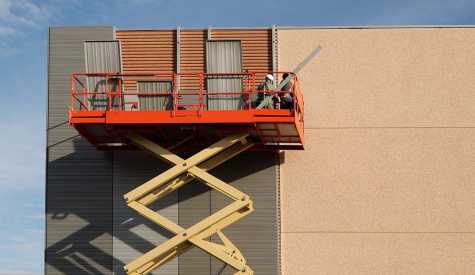Aerial Lift Safety

Aerial lift vehicles are common to many workplaces because of their ability to elevate an individual to perform work in high places. Types of aerial lift devices include aerial ladders, vertical towers and aerial platforms (often referred to as cherry pickers or bucket trucks). Aerial lifts are beneficial and serve to facilitate many different jobs, but they can also be very dangerous.
Hazards
According to OSHA, the top hazards associated with aerial lifts are falls, electrocutions and collapses or tip-overs. Here is a list of the most common aerial lift hazards:
Falls
Falls often occur when a worker doesn’t wear a harness, or fails to properly hook his or her harness to the lift’s platform.
Electrocution
When using aerial lifts near power lines it’s especially important for workers to be aware of their surroundings. Inattention to surroundings can cause a worker to raise the lift’s bucket, causing the individual(s) in the bucket to come in contact with a power line and, in turn, get electrocuted.
Tip-Overs
Injuries sustained from aerial lifts tipping over are often the result of failure to use outriggers when a job takes place on uneven and/or soft ground.
Falling Objects
If worker’s do not stay alert while on an aerial lift platform it’s easy for them to inadvertently make contact with an object, such as a paint bucket or hammer, causing it to fall off the platform and strike someone below.
Structural Failure
Even if the worker(s) using an aerial lift are adhering to safety policies, the aerial lift itself can cause accidents. All machinery needs to be thoroughly inspected before use to ensure there are no safety hazards such as loose bolts or cracks.
Safety Precautions
Although there are many hazards associated with aerial lifts, there are precautions each worker can adhere to that will help keep them safe.
Fall Precautions
- Ensure that access gates or openings are closed
- Stand firmly on floor of lift platform or bucket
- Do not climb on or lean over guardrails
- Do not use planks, ladders or other devises to extend your working position
- Use a body harness with a tether or lanyard attached to the boom or bucket
Overhead Precautions
- Wear a hard hat
- Be aware of clearances (ceiling, overhead and side protruding objects)
- Do not position aerial lifts between overhead hazards if possible
- Until determined, treat all overhead lines as if they are energized power lines and stay at least 10 feet away
- Have power lines of known voltage de-energized if you are required to work within the prescribed safety clearance
Work Area Stability Precautions
- Set outriggers on a level, solid surface, or on outrigger pads if the surface is uneven
- Set brakes when using outriggers
- Use wheel chocks on sloped surfaces when it is safe
- Set up work area warnings, such as cones and signs
Workers Should Never
- Exceed load capacity or boom platform angle limits
- Use the lift as a crane to lift an object
- Carry objects larger than the platform
- Drive with the lift platform raised unless manufacturer’s instructions allow it
- Operate lower level controls unless you have permission from the worker on the lift, except for emergencies
- Exceed vertical or horizontal reach limits
- Operate a lift in winds above speeds recommended by the manufacturer
Inspections
Workers should inspect all components of an aerial lift before using it. This includes fluid levels, wheels, fluid leaks, battery, controls, lights, horns, steering, stabilizers, brakes, structure, wiring, and protective devises. They should also inspect the work area for unstable surfaces such as holes, slopes and loose gravel. The work area also needs to be inspected for obstructions on the ground, walls and ceilings. Additionally, workers should check the weather forecast. Conditions such as wind and ice can jeopardize worker safety when using an aerial lift.
Aerial lifts are dangerous pieces of equipment that require caution and alertness, but if workers follow policies and use good judgment they can create a much safer workplace.
Learn more about safety training online.


